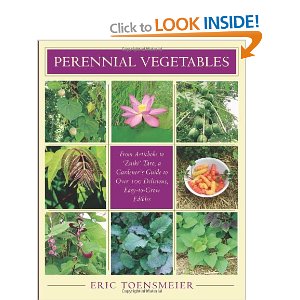Perennial Vegetables
by Sarah - January 4th, 2012.Filed under: Amazon.
Perennial Vegetables – this book comes highly recommended by a friend
 Perennial Vegetables
Perennial Vegetables
Imagine growing vegetables that require the same care as the flowers in your perennial beds and bordersono annual tilling and planting. They thrive and produce abundant and nutritious crops throughout the season. In Perennial Vegetables, author and plant specialist Eric Toensmeier introduces gardeners to a world of little-known and wholly under-appreciated plants. Ranging beyond the usual suspects (asparagus, rhubarb, and artichoke) to include such eminori crops as ground cherry and ramps and the much sought-after, antioxidant-rich wolfberry (also known as goji berries), Toensmeier explains how to raise, tend, harvest, and cook with plants that yield great crops and satisfaction. Perennial vegetables are perfect as part of an edible landscape plan or permaculture garden. Profiling more than a hundred species, with dozens of colour photographs and illustrations, and filled with valuable growing tips, recipes, and resources, Perennial Vegetables is a groundbreaking and ground-healing book that will open the eyes of gardeners everywhere to the exciting world of edible perennials.
 This other book by UK author – Martin Crawford – a director of ‘Gaia’ – is due out on 5 April 2012 – How to Grow Perennial Vegetables: Low-maintenance, Low-impact Vegetable Gardening
This other book by UK author – Martin Crawford – a director of ‘Gaia’ – is due out on 5 April 2012 – How to Grow Perennial Vegetables: Low-maintenance, Low-impact Vegetable Gardening
is well worth putting on your wish list!
Perennial vegetables are a joy to grow and require a lot less time and effort than annuals. In this book Martin Crawford gives comprehensive advice on all types of perennial vegetable (edible plants that live longer than three years), from ground-cover plants and coppiced trees to plants for bog gardens and edible woodland plants. There are many advantages to growing perennial vegetables, for example: * they need less tillage than conventional vegetables and so help retain carbon in the soil * the soil structure is not disturbed in their cultivation * they extend the harvesting season, especially in early spring * and, of course, they are much less work. Part One looks at why and how to grow these crops, and how to look after them for maximum health. Part Two features over 100 perennial edibles in detail, both common and unusual – from rhubarb to skirret; Jerusalem artichoke to nodding onions. This book offers inspiration and information for all gardeners, whether experienced or beginner, and also includes plenty of cooking tips. It includes beautiful colour photographs and illustrations throughout.






